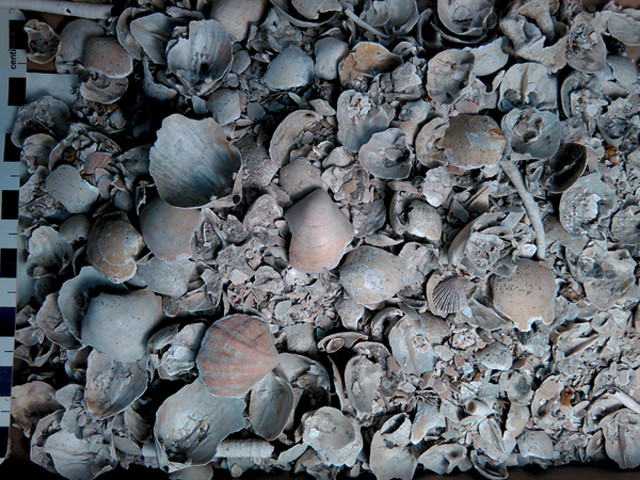
by Lauren Milideo Wednesday, July 19, 2017
When offshore ecosystems deteriorate, scientists often look at changing ocean conditions, urban runoff or fishing as potential explanations. Cows usually don’t come to mind. But new research investigating the seafloor off the coast of Los Angeles suggests that 19th-century cattle, despite their terrestrial lifestyle, left a lasting impact on the underwater habitat there.
University of Chicago geologist Susan Kidwell and Adam Tomašových, a geologist at the Slovak Academy of Sciences, studied how well recent assemblages of invertebrate shells in seafloor sediments on the continental shelf off Southern California represented living marine invertebrate communities. Kidwell, who presented the research in February at the annual meeting of the American Association for the Advancement of Science, built on previous understanding from other regions in which the living and dead assemblages did not match, possibly reflecting anthropogenic effects on local ecology.
Several times each year, wastewater agencies from Orange and Los Angeles counties as well as the city of San Diego collect seafloor mud samples, identifying and counting living species in accordance with the federal Clean Water Act. Interspersed in these samples is debris from deceased organisms, which Kidwell has happily taken off the agencies’ hands. “They’ve been giving me their trash for 10 years now,” she says.
In the samples, Kidwell and Tomašových found evidence of mud-intolerant species of brachiopods, scallops and other filter-feeding invertebrates that prefer gravelly or shelly surfaces and that no longer colonize the area. The researchers radiocarbon-dated some of the brachiopod remains, expecting to find that the organisms had lived during a period of sediment starvation on the continental shelf, likely between about 9,000 and 5,000 years ago when sea levels rose rapidly along the California coast after the last ice age. In fact, the remains were quite a bit younger.
“We just about fell out of our chairs when it came back that there had been brachiopods living out there all the way up through the 19th century,” Kidwell says. “This was a community that had been thriving and perfectly happy … up until the 19th century, when they started to go into decline.”
Kidwell and Tomašových found that brachiopods off Los Angeles began declining by the 1820s and were extirpated by about 1910, but the cause wasn’t immediately clear. So, Kidwell scoured historical information detailing local agriculture, rivers and fisheries, as well as records from range ecologists and geographers, looking for possible explanations.
The area had never been deeply bottom-trawled by fishermen, and overfishing by other means didn’t explain their findings. Neither did warming water temperatures, wastewater management, urbanization or its associated pollutants, all of which were 20th-century phenomena.

Shell fragments, mostly from the brachiopod Laqueus erythraeus, collected in seafloor samples off the Palos Verdes Peninsula suggest that the now-muddy continental shelf off Los Angeles was home to a whole different ecosystem until the 19th century. Credit: Adam Tomašových.
As the researchers rejected “a long list of reasonable alternative explanations,” Kidwell says, and continued examining muddy seafloor samples holding remains of mud-intolerant animals, it became clear that an increasing supply of mud itself to the continental shelf might explain the faunal shift.
In studying Southern California history, Kidwell noted that the Mission Period of the late 18th and early 19th centuries, a time of Spanish colonization in the region, saw an increase in the number of cattle on the landscape, with numbers peaking from the 1830s to the 1850s. Grazing cattle trample and compact the soil under their hooves. Such compaction prevents precipitation from penetrating into the ground, and can increase water and sediment loss from heavily grazed areas by up to 10 times, Kidwell says. Based on historical livestock population data and the area’s carrying capacity — the maximum population size an environment can sustain — she and Tomašových estimated when cows would have boosted sediment runoff as well as how much sediment was leaving Los Angeles’ watershed for the sea. The timing matched the ecological changes offshore, Kidwell says, adding that the enhanced sediment yield to the continental shelf would have continued with later agriculture in the area.
This research shows the widespread effects of terrestrial sediment runoff into the ocean, and has implications for conservation and restoration efforts, Kidwell says. The “impact on marine ecosystems can be really significant, even on the continental shelf.”
Although geologic methods can reveal the pre-19th-century ecosystem on the Southern California continental shelf, which comprised a mosaic of shell gravelly and muddy areas, Kidwell says there’s little chance of fully restoring that ecosystem. “The mud that’s out there on the shelf is the new normal,” she says. However, she adds, “within the foreseeable future, natural ecologic succession will recover [some] habitat back to what it used to be like before the cows.”
Kidwell says it’s important to place a “premium on shell gravel habitat that still exists on the Channel Islands,” which sit off the coast of Los Angeles and preserve environments for sea life that has been displaced from much of the continental shelf.
This research is a good example of conservation paleobiology — using paleontological data and methods to inform modern conservation efforts, says Rowan Lockwood, a paleobiologist at the College of William and Mary in Virginia. “It’s an enormously useful case study of how conservation paleobiology can really illuminate restoration, especially in these coastal environments,” she says.
© 2008-2021. All rights reserved. Any copying, redistribution or retransmission of any of the contents of this service without the expressed written permission of the American Geosciences Institute is expressly prohibited. Click here for all copyright requests.